文化前结构与翻译的创造性误读_林语堂英译_中国传奇_研究
- 格式:pdf
- 大小:122.86 KB
- 文档页数:3
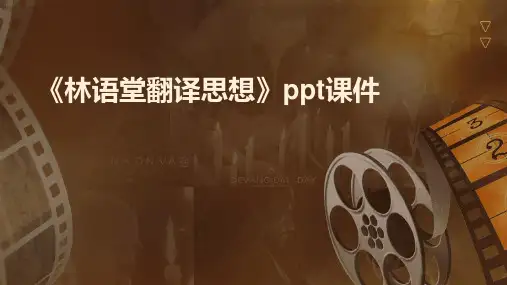
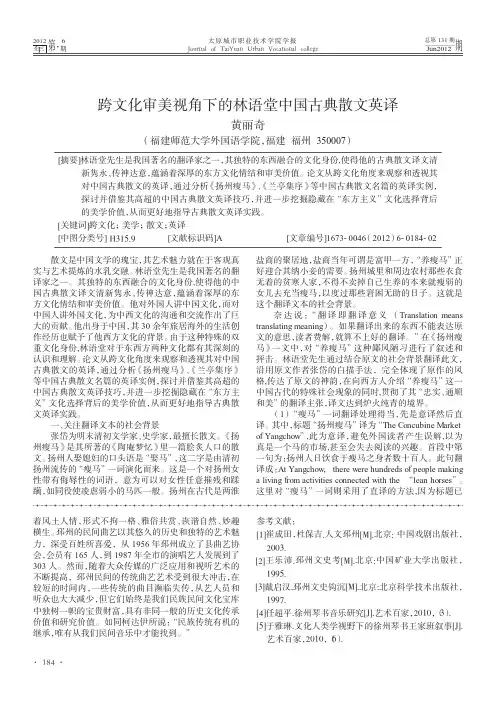
着风土人情,形式不拘一格、雅俗共赏、诙谐自然、妙趣横生。
邳州的民间曲艺以其悠久的历史和独特的艺术魅力,深受百姓所喜爱,从1956年邳州成立了县曲艺协会,会员有165人,到1987年全市的演唱艺人发展到了303人。
然而,随着大众传媒的广泛应用和视听艺术的不断提高,邳州民间的传统曲艺艺术受到很大冲击,在较短的时间内,一些传统的曲目濒临失传,从艺人员和听众也大大减少,但它们始终是我们民族民间文化宝库中独树一帜的宝贵财富,具有非同一般的历史文化传承价值和研究价值。
如同柯达伊所说:“民族传统有机的继承,唯有从我们民间音乐中才能找到。
”2012年第·6期太原城市职业技术学院学报Journal of TaiYuan Urban Vocational college期总第131期Jun2012[摘要]林语堂先生是我国著名的翻译家之一,其独特的东西融合的文化身份,使得他的古典散文译文清新隽永、传神达意,蕴涵着深厚的东方文化情结和审美价值。
论文从跨文化角度来观察和透视其对中国古典散文的英译,通过分析《扬州瘦马》、《兰亭集序》等中国古典散文名篇的英译实例,探讨并借鉴其高超的中国古典散文英译技巧,并进一步挖掘隐藏在“东方主义”文化选择背后的美学价值,从而更好地指导古典散文英译实践。
[关键词]跨文化;美学;散文;英译[中图分类号]H315.9[文献标识码]A[文章编号]1673-0046(2012)6-0184-02跨文化审美视角下的林语堂中国古典散文英译黄丽奇(福建师范大学外国语学院,福建福州350007)散文是中国文学的瑰宝,其艺术魅力就在于客观真实与艺术提炼的水乳交融。
林语堂先生是我国著名的翻译家之一。
其独特的东西融合的文化身份,使得他的中国古典散文译文清新隽永、传神达意,蕴涵着深厚的东方文化情结和审美价值。
他对外国人讲中国文化,而对中国人讲外国文化,为中西文化的沟通和交流作出了巨大的贡献。
他出身于中国,其30余年旅居海外的生活创作经历也赋予了他西方文化的背景。
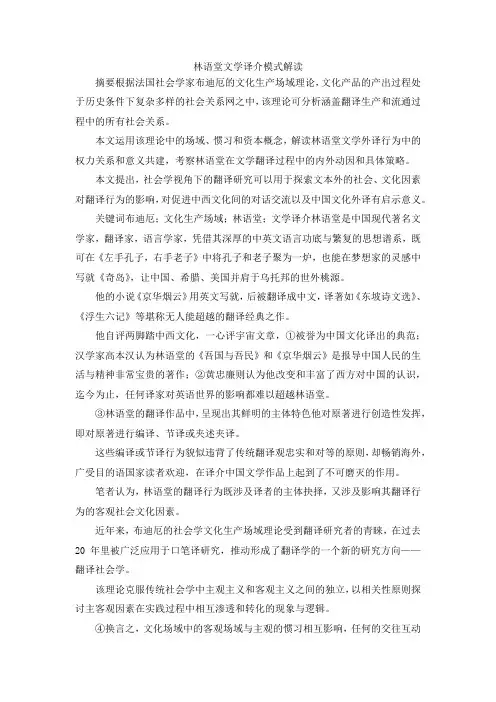
林语堂文学译介模式解读摘要根据法国社会学家布迪厄的文化生产场域理论,文化产品的产出过程处于历史条件下复杂多样的社会关系网之中,该理论可分析涵盖翻译生产和流通过程中的所有社会关系。
本文运用该理论中的场域、惯习和资本概念,解读林语堂文学外译行为中的权力关系和意义共建,考察林语堂在文学翻译过程中的内外动因和具体策略。
本文提出,社会学视角下的翻译研究可以用于探索文本外的社会、文化因素对翻译行为的影响,对促进中西文化间的对话交流以及中国文化外译有启示意义。
关键词布迪厄;文化生产场域;林语堂;文学译介林语堂是中国现代著名文学家,翻译家,语言学家,凭借其深厚的中英文语言功底与繁复的思想谱系,既可在《左手孔子,右手老子》中将孔子和老子聚为一炉,也能在梦想家的灵感中写就《奇岛》,让中国、希腊、美国并肩于乌托邦的世外桃源。
他的小说《京华烟云》用英文写就,后被翻译成中文,译著如《东坡诗文选》、《浮生六记》等堪称无人能超越的翻译经典之作。
他自评两脚踏中西文化,一心评宇宙文章,①被誉为中国文化译出的典范;汉学家高本汉认为林语堂的《吾国与吾民》和《京华烟云》是报导中国人民的生活与精神非常宝贵的著作;②黄忠廉则认为他改变和丰富了西方对中国的认识,迄今为止,任何译家对英语世界的影响都难以超越林语堂。
③林语堂的翻译作品中,呈现出其鲜明的主体特色他对原著进行创造性发挥,即对原著进行编译、节译或夹述夹译。
这些编译或节译行为貌似违背了传统翻译观忠实和对等的原则,却畅销海外,广受目的语国家读者欢迎,在译介中国文学作品上起到了不可磨灭的作用。
笔者认为,林语堂的翻译行为既涉及译者的主体抉择,又涉及影响其翻译行为的客观社会文化因素。
近年来,布迪厄的社会学文化生产场域理论受到翻译研究者的青睐,在过去20年里被广泛应用于口笔译研究,推动形成了翻译学的一个新的研究方向——翻译社会学。
该理论克服传统社会学中主观主义和客观主义之间的独立,以相关性原则探讨主客观因素在实践过程中相互渗透和转化的现象与逻辑。
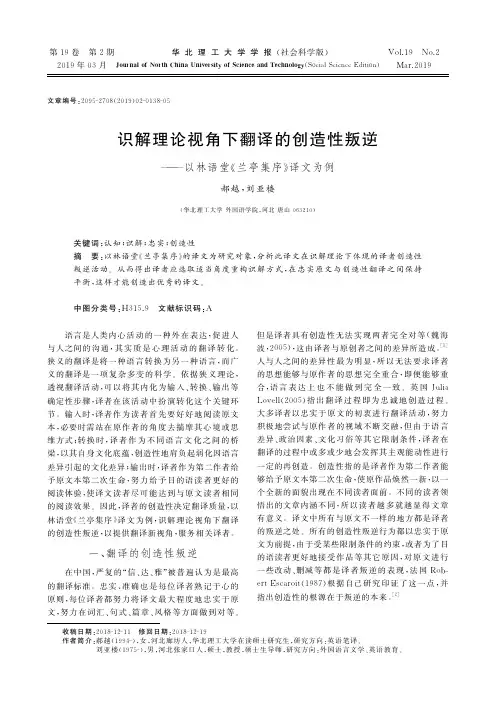
第19卷 第2期华北理工大学学报(社会科学版)Vol.19 No.22019年03月Journal of North China University of Science and Technology(Social Science Edition)Mar.2019收稿日期:2018-12-11 修回日期:2018-12-19作者简介:郝越(1994-),女,河北廊坊人,华北理工大学在读硕士研究生,研究方向:英语笔译。
刘亚楼(1975-),男,河北张家口人,硕士,教授,硕士生导师,研究方向:外国语言文学、英语教育。
文章编号:2095-2708(2019)02-0138-05识解理论视角下翻译的创造性叛逆———以林语堂《兰亭集序》译文为例郝越,刘亚楼(华北理工大学外国语学院,河北唐山063210)关键词:认知;识解;忠实;创造性摘 要:以林语堂《兰亭集序》的译文为研究对象,分析此译文在识解理论下体现的译者创造性叛逆活动。
从而得出译者应选取适当角度重构识解方式,在忠实原文与创造性翻译之间保持平衡,这样才能创造出优秀的译文。
中图分类号:H315.9 文献标识码:A 语言是人类内心活动的一种外在表达,促进人与人之间的沟通,其实质是心理活动的翻译转化。
狭义的翻译是将一种语言转换为另一种语言,而广义的翻译是一项复杂多变的科学。
依据狭义理论,透视翻译活动,可以将其内化为输入、转换、输出等确定性步骤,译者在该活动中扮演转化这个关键环节。
输入时,译者作为读者首先要好好地阅读原文本,必要时需站在原作者的角度去揣摩其心境或思维方式;转换时,译者作为不同语言文化之间的桥梁,以其自身文化底蕴,创造性地肩负起弱化因语言差异引起的文化差异;输出时,译者作为第二作者给予原文本第二次生命,努力给予目的语读者更好的阅读体验,使译文读者尽可能达到与原文读者相同的阅读效果。
因此,译者的创造性决定翻译质量,以林语堂《兰亭集序》译文为例,识解理论视角下翻译的创造性叛逆,以提供翻译新视角,服务相关译者。
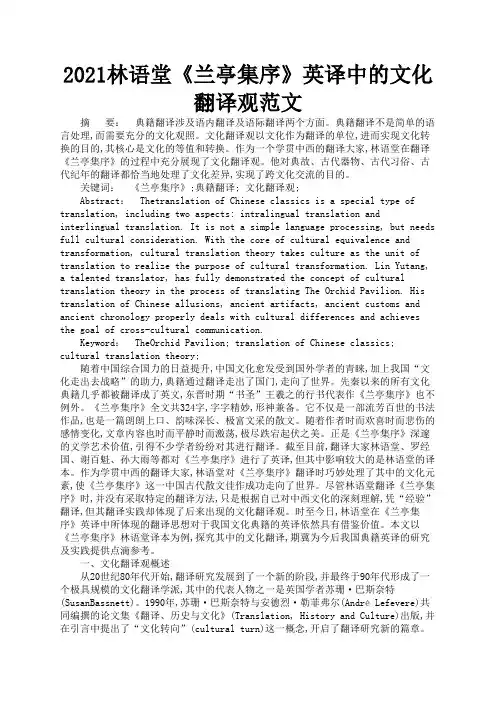
2021林语堂《兰亭集序》英译中的文化翻译观范文 摘要: 典籍翻译涉及语内翻译及语际翻译两个方面。
典籍翻译不是简单的语言处理,而需要充分的文化观照。
文化翻译观以文化作为翻译的单位,进而实现文化转换的目的,其核心是文化的等值和转换。
作为一个学贯中西的翻译大家,林语堂在翻译《兰亭集序》的过程中充分展现了文化翻译观。
他对典故、古代器物、古代习俗、古代纪年的翻译都恰当地处理了文化差异,实现了跨文化交流的目的。
关键词: 《兰亭集序》;典籍翻译; 文化翻译观; Abstract: Thetranslation of Chinese classics is a special type of translation, including two aspects: intralingual translation andinterlingual translation. It is not a simple language processing, but needs full cultural consideration. With the core of cultural equivalence and transformation, cultural translation theory takes culture as the unit of translation to realize the purpose of cultural transformation. Lin Yutang, a talented translator, has fully demonstrated the concept of cultural translation theory in the process of translating The Orchid Pavilion. His translation of Chinese allusions, ancient artifacts, ancient customs and ancient chronology properly deals with cultural differences and achieves the goal of cross-cultural communication. Keyword: TheOrchid Pavilion; translation of Chinese classics;cultural translation theory; 随着中国综合国力的日益提升,中国文化愈发受到国外学者的青睐,加上我国“文化走出去战略”的助力,典籍通过翻译走出了国门,走向了世界。
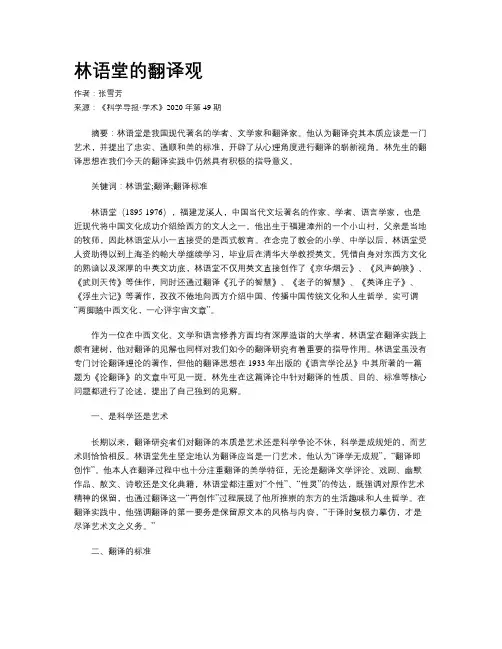
林语堂的翻译观作者:张雪芳来源:《科学导报·学术》2020年第49期摘要:林语堂是我国现代著名的学者、文学家和翻译家。
他认为翻译究其本质应该是一门艺术,并提出了忠实、通顺和美的标准,开辟了从心理角度进行翻译的崭新视角。
林先生的翻译思想在我们今天的翻译实践中仍然具有积极的指导意义。
关键词:林语堂;翻译;翻译标准林语堂(1895-1976),福建龙溪人,中国当代文坛著名的作家、学者、语言学家,也是近现代将中国文化成功介绍给西方的文人之一。
他出生于福建漳州的一个小山村,父亲是当地的牧师,因此林语堂从小一直接受的是西式教育。
在念完了教会的小学、中学以后,林语堂受人资助得以到上海圣约翰大学继续学习,毕业后在清华大学教授英文。
凭借自身对东西方文化的熟谙以及深厚的中英文功底,林语堂不仅用英文直接创作了《京华烟云》、《风声鹤唳》、《武则天传》等佳作,同时还通过翻译《孔子的智慧》、《老子的智慧》、《英译庄子》、《浮生六记》等著作,孜孜不倦地向西方介绍中国、传播中国传统文化和人生哲学。
实可谓“两脚踏中西文化,一心评宇宙文章”。
作为一位在中西文化、文学和语言修养方面均有深厚造诣的大学者,林语堂在翻译实践上颇有建树,他对翻译的见解也同样对我们如今的翻译研究有着重要的指导作用。
林语堂虽没有专门讨论翻译理论的著作,但他的翻译思想在1933年出版的《语言学论丛》中其所著的一篇题为《论翻译》的文章中可见一斑。
林先生在这篇译论中针对翻译的性质、目的、标准等核心问题都进行了论述,提出了自己独到的见解。
一、是科学还是艺术长期以来,翻译研究者们对翻译的本质是艺术还是科学争论不休,科学是成规矩的,而艺术则恰恰相反。
林语堂先生坚定地认为翻译应当是一门艺术,他认为“译学无成规”,“翻译即创作”。
他本人在翻译过程中也十分注重翻译的美学特征,无论是翻译文学评论、戏剧、幽默作品、散文、诗歌还是文化典籍,林语堂都注重对“个性”、“性灵”的传达,既强调对原作艺术精神的保留,也通过翻译这一“再创作”过程展现了他所推崇的东方的生活趣味和人生哲学。
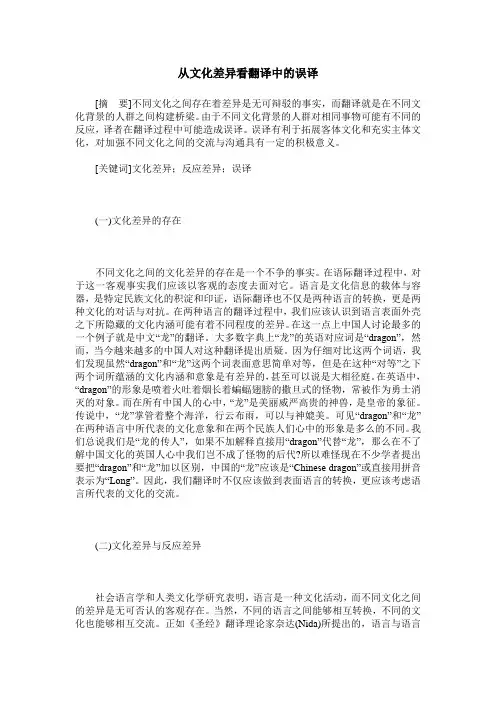
从文化差异看翻译中的误译[摘要]不同文化之间存在着差异是无可辩驳的事实,而翻译就是在不同文化背景的人群之间构建桥梁。
由于不同文化背景的人群对相同事物可能有不同的反应,译者在翻译过程中可能造成误译。
误译有利于拓展客体文化和充实主体文化,对加强不同文化之间的交流与沟通具有一定的积极意义。
[关键词]文化差异;反应差异;误译(一)文化差异的存在不同文化之间的文化差异的存在是一个不争的事实。
在语际翻译过程中,对于这一客观事实我们应该以客观的态度去面对它。
语言是文化信息的载体与容器,是特定民族文化的积淀和印证,语际翻译也不仅是两种语言的转换,更是两种文化的对话与对抗。
在两种语言的翻译过程中,我们应该认识到语言表面外壳之下所隐藏的文化内涵可能有着不同程度的差异。
在这一点上中国人讨论最多的一个例子就是中文“龙”的翻译。
大多数字典上“龙”的英语对应词是“dragon”,然而,当今越来越多的中国人对这种翻译提出质疑。
因为仔细对比这两个词语,我们发现虽然“dragon”和“龙”这两个词表面意思简单对等,但是在这种“对等”之下两个词所蕴涵的文化内涵和意象是有差异的,甚至可以说是大相径庭。
在英语中,“dragon”的形象是喷着火吐着烟长着蝙蝠翅膀的撒旦式的怪物,常被作为勇士消灭的对象。
而在所有中国人的心中,“龙”是美丽威严高贵的神兽,是皇帝的象征。
传说中,“龙”掌管着整个海洋,行云布雨,可以与神媲美。
可见“dragon”和“龙”在两种语言中所代表的文化意象和在两个民族人们心中的形象是多么的不同。
我们总说我们是“龙的传人”,如果不加解释直接用“dragon”代替“龙”,那么在不了解中国文化的英国人心中我们岂不成了怪物的后代?所以难怪现在不少学者提出要把“dragon”和“龙”加以区别,中国的“龙”应该是“Chinese dragon”或直接用拼音表示为“Long”。
因此,我们翻译时不仅应该做到表面语言的转换,更应该考虑语言所代表的文化的交流。
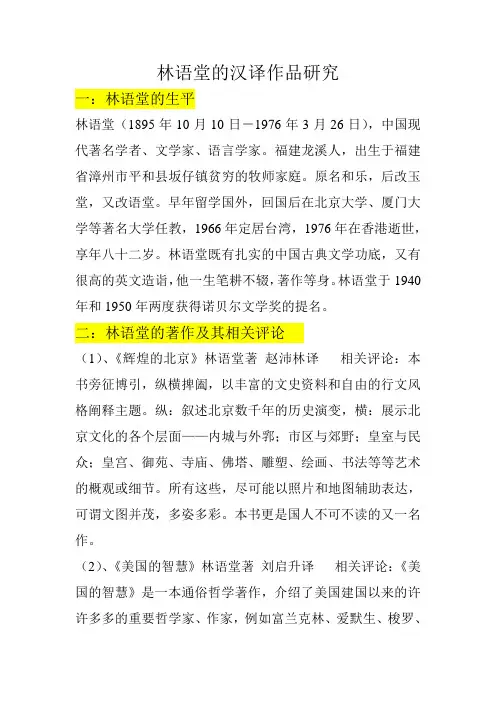
林语堂的汉译作品研究一:林语堂的生平林语堂(1895年10月10日-1976年3月26日),中国现代著名学者、文学家、语言学家。
福建龙溪人,出生于福建省漳州市平和县坂仔镇贫穷的牧师家庭。
原名和乐,后改玉堂,又改语堂。
早年留学国外,回国后在北京大学、厦门大学等著名大学任教,1966年定居台湾,1976年在香港逝世,享年八十二岁。
林语堂既有扎实的中国古典文学功底,又有很高的英文造诣,他一生笔耕不辍,著作等身。
林语堂于1940年和1950年两度获得诺贝尔文学奖的提名。
二:林语堂的著作及其相关评论(1)、《辉煌的北京》林语堂著赵沛林译相关评论:本书旁征博引,纵横捭阖,以丰富的文史资料和自由的行文风格阐释主题。
纵:叙述北京数千年的历史演变,横:展示北京文化的各个层面——内城与外郛;市区与郊野;皇室与民众;皇宫、御苑、寺庙、佛塔、雕塑、绘画、书法等等艺术的概观或细节。
所有这些,尽可能以照片和地图辅助表达,可谓文图并茂,多姿多彩。
本书更是国人不可不读的又一名作。
(2)、《美国的智慧》林语堂著刘启升译相关评论:《美国的智慧》是一本通俗哲学著作,介绍了美国建国以来的许许多多的重要哲学家、作家,例如富兰克林、爱默生、梭罗、桑塔雅那等等,内容涉及到社会生活的方方面面:生活、生命、情感、自由、幸福、自然、宗教、幽默与讽刺、爱情与婚姻、战争与和平,等等。
林语堂提倡“以自我为中心,以闲适为格调”的小品文创作。
在本书中,林先生挥毫泼墨,收放自如,真正体现了这一风格。
阅读本书,犹如与大师面对面交谈,心灵会得到一次净化和升华。
(3)、《中国传奇》林语堂著张振玉译相关评论:本书是作者又一部向西方介绍中国传统文化的典型力作,书中一共收录中国古代最著名的短篇小说杰作20篇,按照小说内容的属性分成:神秘与冒险、爱情、鬼怪、讽刺、幻想与幽默、童话等六大类。
这些短篇小说的主旨在于描写人性,一针见血,或加深读者对人生的了解,或唤起人类的侧隐之心、爱、同情心,而给予读者以愉快之感。
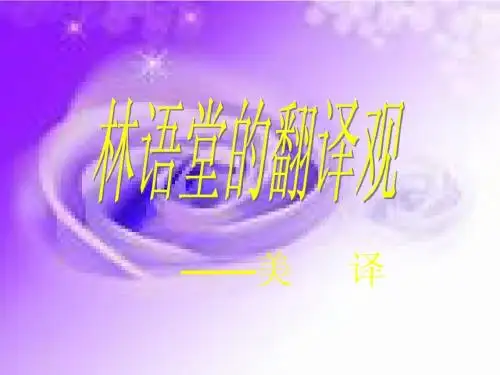
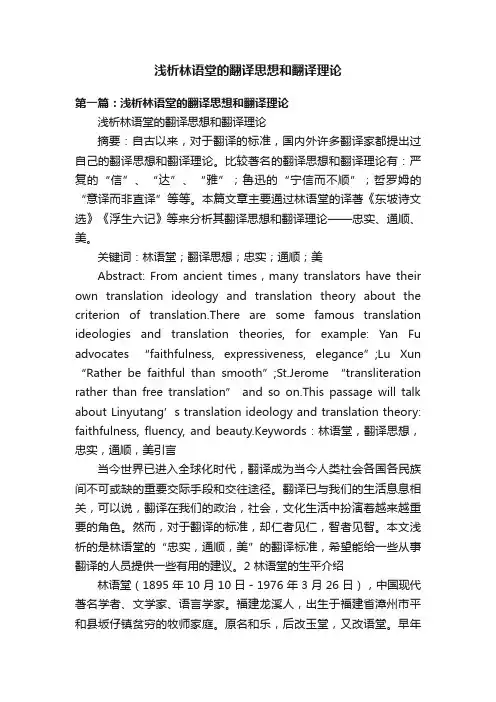
浅析林语堂的翻译思想和翻译理论第一篇:浅析林语堂的翻译思想和翻译理论浅析林语堂的翻译思想和翻译理论摘要:自古以来,对于翻译的标准,国内外许多翻译家都提出过自己的翻译思想和翻译理论。
比较著名的翻译思想和翻译理论有:严复的“信”、“达”、“雅”;鲁迅的“宁信而不顺”;哲罗姆的“意译而非直译”等等。
本篇文章主要通过林语堂的译著《东坡诗文选》《浮生六记》等来分析其翻译思想和翻译理论——忠实、通顺、美。
关键词:林语堂;翻译思想;忠实;通顺;美Abstract: From ancient times,many translators have their own translation ideology and translation theory about the criterion of translation.There are some famous translation ideologies and translation theories, for example: Yan Fu advocates “faithfulness, expressiveness, elegance”;Lu Xun “Rather be faithful than smooth”;St.Jerome “transliteration rather than free translation” and so on.This passage will talk about Linyutang’s transl ation ideology and translation theory: faithfulness, fluency, and beauty.Keywords:林语堂,翻译思想,忠实,通顺,美引言当今世界已进入全球化时代,翻译成为当今人类社会各国各民族间不可或缺的重要交际手段和交往途径。
翻译已与我们的生活息息相关,可以说,翻译在我们的政治,社会,文化生活中扮演着越来越重要的角色。
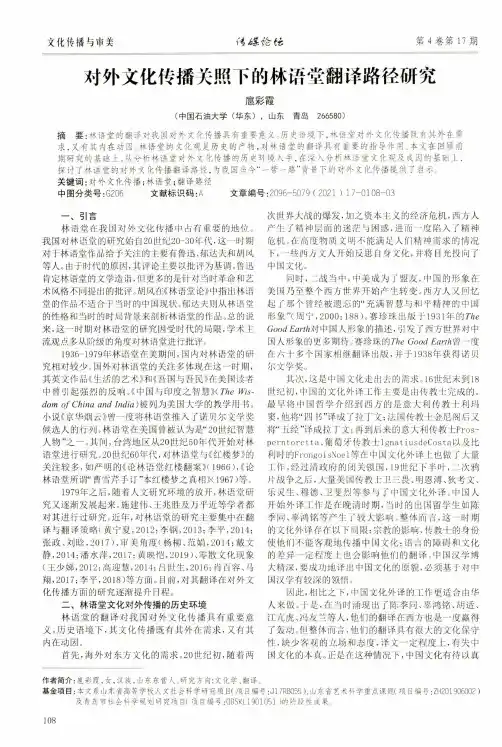
第4卷第17期文化传播与审美对外文化传播关照下的林语堂翻译路径研究扈彩霞(中国石油大学(华东),山东青岛266580)摘要:林语堂的翻译对我国对外文化传播具有重要意义。
历史语境下,林语堂对外文化传播既有其外在需求,又有其内在动因。
林语堂的文化观是历史的产物,对林语堂的翻译具有重要的指导作用。
本文在回顾前期研究的基础上,从分析林语堂对外文化传播的历史环境入手,在深入分析林语堂文化观及成因的基础上,探讨了林语堂的对外文化传播翻译路径,为我国当今“一带一路”背景下的对外文化传播提供了启示。
关键词:对外文化传播;林语堂;翻译路径中图分类号:G206文献标识码:A文章编号:2096-5079(2021)17-0108-03—、引言林语堂在我国对外文化传播中占有重要的地位。
我国对林语堂的研究始自20世纪20-30年代,这一时期对于林语堂作品给予关注的主要有鲁迅、郁达夫和胡风等人。
由于时代的原因,其评论主要以批评为基调。
鲁迅肯定林语堂的文学造诣,但更多的是针对当时革命和艺术风格不同提出的批评。
胡风在《林语堂论》中指出林语堂的作品不适合于当时的中国现状。
郁达夫则从林语堂的性格和当时的时局背景来剖析林语堂的作品。
总的说来,这一时期对林语堂的研究因受时代的局限,学术主流观点多从阶级的角度对林语堂进行批评。
1936-1979年林语堂在美期间,国内对林语堂的研究相对较少。
国外对林语堂的关注多体现在这一时期,其英文作品《生活的艺术》和《吾国与吾民》在美国读者中曾引起强烈的反响。
《中国与印度之智慧NThe Wisdom of China and/"dia)被列为美国大学的教学用书。
小说《京华烟云》曾一度将林语堂推入了诺贝尔文学奖候选人的行列。
林语堂在美国曾被认为是“20世纪智慧人物”之一。
其间,台湾地区从20世纪50年代开始对林语堂进行研究。
20世纪60年代,对林语堂与《红楼梦》的关注较多,如严明的《论林语堂红楼翻案》(1966),《论林语堂所谓“曹雪芹手订”本红楼梦之真相X1967)等。
林语堂英文作品翻译之特点吴玲玲李丹(四川大学外国语学院四川成都610000)摘要:林语堂是中国著名的双语作家、语言学家、翻译家。
他用英语写成并且翻译了诸多作品。
林氏作品基本上以反映中国近代社会的政治、生活现状为题材,所以,翻译此类作品,与翻译其他反映外来事物的作品相比,具有自己的特点。
本文就这些特点进行分析,希望是对林氏作品汉译的又一次有益探索。
关键词:双语作家中国文化归化异化回译林语堂,幼名和乐,后名玉堂,笔名语堂,是中国现代著名作家、学者,1895年10月10日出生于福建省龙溪县坂仔村一个清贫和睦的牧师家庭,1976年3月26日在香港去世。
常年旅居海外,受到东西方文化共同影响的林语堂“两脚踏中西文化,一心评宇宙文章”。
这种经历使林氏的作品独具特色,虽多用英文写成,却紧扣中国社会文化。
自然,我们不能毫无差别地对待林语堂英文作品的翻译与其他英文作品的翻译。
本文从翻译主体、翻译客体与翻译过程3个方面阐述了林语堂英文作品汉译的特点。
一、翻译主体上自译与他译并存1.林语堂是以英文写作为主的双语作家,使自译成为可能林语堂曾就读于上海圣约翰大学、美国哈佛大学、德国莱比锡大学,外文功底十分了得。
他的成名作《吾国与吾民》(M y C ountr y and M y Peo p le)就是用英文写成。
随后,林语堂的英文作品《生活的艺术》(T he i m P ort ance o f L io in g)、《京华烟云》(M o m ent in pekin g)、《孔子的智慧》(T he w is do m o f C on f ucius)、《苏东坡传》(T he G a y G enius:T he L i f e and T i m es o f Su T on g po)、《红牡丹》(T he r ed peon y)等相继问世,在国际社会上引起好评。
作为《语丝》主要撰稿人,林语堂又创办了《论语》、《人间世》、《宇宙风》,并发表了大量小品文,以闲适小品文和幽默小品文著称。
035[摘 要] 语言是文化的载体,每种语言中都富含具有鲜明文化特色的词汇,即文化负载词。
文化负载词的翻译对于文化传播和交流有重要意义。
以林语堂英译《大学》中社会文化负载词为例,分析其翻译方法之得失。
其所采用的直译法易于读者理解,但在一定程度上造成了源语文化内涵的缺失。
在新的历史环境下,应尝试探寻译介文化负载词的更多方法。
[关 键 词] 林语堂;大学;文化负载词;翻译林语堂英译《大学》中社会文化负载词的翻译方法探究刘博欣为了响应国家文化“走出去”战略,近年来学界越来越关注典籍作品的翻译或重译工作。
典籍作品中蕴含着大量具有中国文化特色的词汇,如何对其进行翻译值得深思。
《大学》作为《四书》之首,为儒学入门之典籍,千百年来对中国文化产生了深远影响。
林语堂编译的《孔子的智慧》系统地向西方读者介绍孔子及其思想,该书曾在国际社会产生过强烈反响。
《大学》作为其中的一个篇章,阐发了君子修身以达到至善从而平复天下的哲学思想。
语篇中出现了大量具有中国文化特色的词汇,这些词汇只有通过恰当的翻译和阐释才能向读者传递其真正的文化内涵。
本文通过对其译本中社会文化负载词进行分析,探求译介文化负载词的更好方法,助力中国文化“走出去”。
一、文化负载词的概念及分类文化负载词又称为文化空缺词、文化专有项,指各民族在发展过程中,因不同的地理位置、社会历史环境、政治、经济、宗教信仰等方面的差异,形成的独具民族特色的词汇。
这些词汇反映了特定民族在漫长历史进程中逐渐积累的、有别于其他民族的独特的活动方式(廖七一,2000:232)。
美国学者尤金·奈达把文化负载词分成了五类,即生态文化负载词、物质文化负载词、社会文化负载词、语言文化负载词和宗教文化负载词(Nida, 1993:67)。
其中社会文化负载词指涉及一个民族的风土人情、社会关系、生活方式、政治制度、伦理道德等方面的词汇。
《大学》通过引用历史人物名言或历史事件论证修身之重要性,所以语篇中出现了很多帝王名、朝代名等专有名词,如尧舜、文王、周、殷等;除此以外,还有大量反映儒学思想的词汇,如仁、德、孝、敬、信、君子、至善等。
变形记——林语堂对古代传奇的现代改写单原摘要:情节曲折跌宕、想像瑰丽的中国传奇故事,充满了生命的力量和对人性的洞察,是林语堂先生选择的向西方读者介绍中国文化的理想载体,但又必须去芜存菁,改写为可读性更强的现代小说叙事模式。
本文选取了林语堂编译的《英译重编传奇小说》中的三篇:《促织》、《薛伟》、《张逢》三篇,分别是人变蟋蟀、人变鱼和人变老虎,剖析林语堂先生从古代传奇中提取现代母题并进行改写的策略和技巧。
关键词:林语堂;变形记;《英译重编传奇小说》中图分类号1207.41文献标识码:A文章编号:1005-5312 (2020)15-0013-02一、前言“两脚踏东西文化,一心著宇宙文章”的林语堂先生是上个世纪将中国文化传播到英美国家最成功的译者之一。
对于林先生的成功,不能囿于语言层而,而应从历史、文化及心理方而综合剖析。
亦编亦著亦译的林语堂先生在系统性阐述自己的翻译观点<论翻译》一文(初作于1932年,作为吴曙天编选的《翻译论》的论一书序,后又收入林语堂的《语言学论丛》一书中)认为“翻译即创作”,认为翻译文学作品的人,“须把翻译自身事业也当作一种艺术”。
文艺翻译家“必先把其所译作者之风度神韵预先认出,于译时复极力发挥,才是尽译艺术文之义务”。
在翻译即创作的思想引领下,林语堂的译作比传统的译者享有更大的自由,这在译本《英译重编传奇小说》中得到了充分的体现:林译本以东西方文化交流为目的,一方而渗透了自己对世界、对人生的认识和审美思考;一方而也参考了西方现代小说的特点,重情节也重人性刻画,在细节方而很多也顺应了西方读者的生活和思维习惯。
二、精神内核——译本选择的关键喜欢听故事是人类的天性,《一千零一夜》、《安徒生童话》等文化就是跨越时代、跨越国界和语言成功例证。
中国历史悠长,的确是不乏好故事,但是林语堂先生却对传奇情有独钟,主要还是因为其精神内核更具有民族的共通性。
“传奇中的想象像英国伊丽莎白时代那样无拘无束,故事更加轻松生动,即便是后人现实主义的加工也不能阻止想象的翱翔。
2472020年34期总第526期ENGLISH ON CAMPUS浅析林语堂的翻译思想、策略和技巧——以《浮生六记》英译本为例文/李媛媛译。
至于“美”这一标准,与林语堂把翻译看作艺术有关。
译文要追求内容和形式上的“美”,但当两者矛盾时,就要放弃形式。
林语堂认为,翻译其实主要和译者的心理及目的语两者之间的关系有关,他“把严复的翻译理论从文字的技巧,提升到了美学心理学的高度”。
2. 译者的素质。
林语堂对于翻译者所应有的素质,也给出了清晰的界定。
总结起来就是译者要精通双语,既要能读懂原文,又要能熟练地用目的语来表达,同时要知道好的翻译标准,以及翻译时应该采用的策略。
林语堂的翻译思想丰富而深厚,翻译的标准与译者的素质,只是笔者从他的思想中简要提取的核心问题。
本文以林语堂翻译的《浮生六记》英文本为例,分析他在翻译时采取的策略。
以及其翻译思想在其中的体现。
三、林语堂在《浮生六记》英译本中采取的翻译策略和技巧林语堂认为“直译”“意译”这种说法就是不恰当的,会让人误认为翻译的标准似乎可以有两个。
其实标准应该只有一个,好的译作应该能灵活地运用这两者,一方面不失原意,另一方面能够兼顾译文流畅。
本文在探讨时,会从 “异化”和“归化”两个大的原则下细分讨论。
1. 异化。
这是一种保留原语文化的翻译策略,在翻译中是非常重要的,能够促进文化交流。
例如,书名“浮生六记”,沈复化用了李白的诗句“浮生若梦,为欢几何”,极具本土色彩,里面蕴含的文化意象是西方读者需要用心领会的。
林语堂采用异化策略,他将“浮生六记”直译成“six chapters of a floating life”,并且译本在国外销量很好,可见,外国读者可以接受。
下面探讨的是林语堂在异化策略下,所采用的音译和直译技巧的情况。
(1)音译。
方梦之在《译学辞典》中对音译的定义是,音译“也称转写,即用一种文字符号(如拉丁字母)来表示另一种文字系统的文字符号(如汉字)的过程或结果。
苏轼诗词英译中意象的传递——以林语堂译本为例摘要:在全球化发展背景下,文学翻译的重要性日益凸显。
文学翻译一直以来都是文化交流的桥梁,通过将一个文学作品从一种语言转化为另一种语言,传递着作者的思想、情感以及文化内涵。
苏轼作为中国古代文学巨匠之一,其诗词充满着丰富的文化意象,通过意象传递着多样的创作情感。
只有对意象进行恰当的翻译,才能正确传递诗词情感,以及文字背后蕴藏的传统文化。
本文以林语堂的英译为例,探讨在英译过程中苏轼诗词所蕴含的色彩、物质和历史文化意象的传递。
关键词:苏轼诗词英译;意象传递;林语堂译本前言:文学翻译是一项既具有挑战性又深具创造性的任务,它在不同语境中传递着作品的思想、情感,以及独特的文化精髓。
苏轼的诗歌被视为中华文学的瑰宝,其中蕴含着深刻的文化内涵和独特意象。
研究苏轼的作品在英语翻译中的呈现,旨在探讨文学意象如何在跨文化传播中得以保留和再现。
本文选择林语堂的翻译作为研究对象,因为他以其深厚的文学造诣和跨文化沟通能力而著称,其翻译不仅准确传递文字,更展示对文学情感和意象的敏感把握。
一、色彩文化意象翻译色彩在苏轼的诗词中扮演着重要的角色,不仅是对自然景物的描绘,更是表达情感和抒发思想的载体。
林语堂在翻译过程中,通过巧妙的词汇选择和细腻的描写,成功地传递苏轼诗中的丰富色彩文化意象。
在苏轼的诗中,常见的色彩意象包括梅花的素白、春草的嫩绿、夏日的鲜红等[1]。
这些颜色不仅仅是对自然界的真实描绘,更是情感和思想的象征。
林语堂在翻译时避免简单的直译,而是选用恰如其分的英文词汇,使得色彩的丰富在英文中得到呈现。
例如在《殢人娇·或云赠朝云》翻译中,林语堂用“cherry lips”传递苏轼的“朱唇”,并没有采用直译的“red lips”。
这样的意象翻译方式,成功规避“红色”在西方文化中的负面含义,而是通过“cherry”让人们去联想美人的樱桃小嘴,从而更加彰显出美人的貌美。
同时,林语堂先生在翻译“敛云”这个词时受到中西文化差异影响,通过意译方法合理增添文化意象传递,将这诗词翻译为“or letting them archly fall”。
文化前结构与翻译的创造性误读)))林语堂英译5中国传奇6研究y杨 柳(湖南大学 外国语学院,湖南 长沙 410082)[摘 要]翻译的创造性误读是指译者对原作进行的有意识的改变和重写。
从著名翻译家林语堂的英译本5中国传奇6出发,作者分析了翻译的创造性误读的表现形式与文化前结构之间的关系,并指出,创造性误读并非是对原作和文化的亵渎,而是文学生产和文化接受过程中的一种有效手段,对翻译研究与翻译实践具有方法论的指导意义。
[关键词]创造性误读;文化前结构;翻译;5中国传奇6;林语堂;文化接受[中图分类号]H059 [文献标识码]A [文章编号]1008-1763(2003)06-00101-03Cultural Pre -structure and Creative Misreading in Translation)))A case study of Chinese Famous Short Stories translated by Lin Yu -tangYAN G Liu(Co lleg e of F oreig n L anguages,Hunan U niv ersity ,Changsha 410082China)Abstract:Creative m isreading in translation refers to the purposeful rew riting of the source tex t by translators and can be closely related to the pre-structure or cultural presuppositio n.In this essay ,the au -thor analy zes the relationship betw een pre-structure and the creative misreading ,based on the studies o f Chinese Famous Shor t Stories translated by Lin Yu -tang.T he author also points out that creative misread -ing is not m isunderstanding and abusive reading but an effective policy or strategy in literature production and acculturatio n.Key words:creative m isreading ;pre-structure;translation;Chinese Famous Short Stor ies ;Lin Yu -tang ;acculturatio n文化前结构与误读种类文化,作为/知识、信仰、艺术、道德、风俗以及人作为社会的一员可以习得的其他能力或习惯0,/是可以为人类所习得、为社区成员所共有、可以整合的符号系统0(Edw ar d T y -lo r,转自M eta )[1](P134)。
这一系统包括语言系统、技术-经济系统、社会系统和意识形态系统,它们相互作用,决定了不同的民族具有不同的基本理念、信仰、意识、图示和思维方式,这就是海德格尔所说的文化/前结构(pr e -str uctur e)0(M eta)[1](P134)。
文化前结构根植于人的脑海之中,潜意识地制约着人类行为。
一般而论,人类对于本民族的历史文化具有鲜明的价值取向,对/自我0的认同与对/他者0的排斥常常导致不同的/前理解(pr e -understanding )0(伽达默尔),由此而导致文化交往中的贬值性误读(devaluated misreading );而由于对/他者0文化缺乏足够的了解进而导致乌托邦式的文化幻想,便会产生浪漫的误读(r omant ic misreading );本文所要探讨的是第三种误读:创造性误读(cr eativ e misr ea ding )。
它是对前文本的一种创造性解读方式,是对文本的刻意/重写0(rew r iting )(Hazar d A dams &Searle)[2](P330),是对/他者0文化或/我者0文化有意识的择取,其主要目的是用/他者0文化来完善/自我0,或用/自我0去弥补/他者0,从而达到文化移入或文化融合的目的。
在本文中,作者将以著名文化y[收稿日期]2003-06-11[作者简介]杨 柳(1965)),女,湖南醴陵人,湖南大学外国语学院副教授,南京大学外国语学院博士生1第17卷 第6期2003年11月湖 南 大 学 学 报(社会科学版)Journal o f H unan U niversit y(So cial Sciences)Vo l.17,N o.6N o v .2003家、文学家和翻译家林语堂的英译作品5中国传奇6为切入点,讨论文化前结构与翻译的创造性误读的关系和表现特点,以期对翻译研究和文化接受问题提供策略参考和理论指导。
从林译5中国传奇6看翻译的创造性误读5中国传奇6(Chinese Fam ous S hor t S tor ies)是林语堂根据中国古代著名短篇小说杰作编译而成的一部短篇小说集。
林语堂的这部译作面向西洋读者,他从5太平广记6、5京本通俗小说6、5清尊录6、5聊斋志异6和5清平山堂丛书6等古本中选择了二十篇有代表性的传奇故事,集冒险、爱情、鬼怪、讽刺、幻想、幽默和童话于一体,通过改编、删节、增译等策略将原文改造,以英文重写,整合成新的文本形式,于1948年在美国出版,并多次重印,被美国读者广泛接受。
林语堂的这一译本对翻译研究来说最引人注目的乃是他对选材的把握和对原本实行创造性误读并/改头换面0于无形的高超策略。
在选材方面,林语堂在其英文本导言中表明,此书乃为西洋读者所作,故选材与重编皆受限制。
因主题、素材或社会与时代的基本差异致使许多名篇未能选入。
所选故事皆具普适性,并且符合现代短篇小说的主旨(L in Y u-tang)0[3](P143)。
他还一再强调,/短篇小说之主旨在于描写人性,一针见血,或加深读者对人生之了解,或唤起人类之恻隐心、爱、同情心,而予读者以愉快之感。
小说当具普及性,不当有基本上不可解处,不当费力解释,而后方能达到预期之目的0(林语堂、张振玉)[4](P1)。
因此,在所选篇目中,有/若干篇具有远方远代之背景与气氛,虽有异国情调与稀奇特殊之美,但无隔阂费解之处0(林语堂、张振玉)[4](P1)。
显然,林语堂考虑的主要是读者的口味(W ester n r eader)、社会、时代的差异和现代短篇小说的主旨。
/普及性0(univ ersal appeal)和/文学性0(a nsw er mo re to t he purpose of a mo der n sho rt stor ies)是他进行材料甄选和再创作的主要依据和原则。
据此,林氏对二十篇入选的故事全部进行了加工。
比如,在/白猿传0中加入了番人风俗材料并改变了原文主题;在/碾玉观音0中,故事结局完全改变,译作的前半部随原作,后半部却自行发展,以艺术创作与作者生活为主题,阐述大艺术家是应为掩藏其真的自我而毁灭其作品抑或使作品显示其真的自我;在/莺莺传0这则著名的爱情故事中,译者增译了大量的古体诗词,以增加其浪漫色彩;而/诗社0一篇原用来讽刺宋代诗人,译者认为原作中的诗歌属于/禽兽之诗0,无翻译之价值,故将原作彻底改观,原文中各诗人之姓名皆暗示其个性,故其名以英文译出,对姓氏文化作了/归化0处理(林语堂、张振玉)[4](P1)。
然而,在这些/误读0之中,最具创造性的范例还来自林语堂对/简贴和尚0(即/无名信0)(T he Strang er c s N ote)和/狄氏0(M adame D)这两篇小说的改编。
/简帖和尚0被林语堂誉为/中国文学中最佳之犯罪小说0(林语堂、张振玉)[4](P3)。
在译作整合过程中,林语堂选取了原作的主要线索,但改变了男女主人公的/脸孔0和命运:原作把故事的男主人洪某(t he str ang er)塑造成一个彻头彻尾的、乔装成和尚的骗子和恶棍,女主人公皇甫氏原为怯懦无能、忍气吞声之辈;而译作中的洪某却既英俊风趣、又慷慨殷勤,皇甫氏则既温柔漂亮、又聪明果敢,嫁给粗暴、狭隘的前夫犹如/天鹅嫁给了癞蛤蟆0,因此,纵使前夫在休妻之后又萌生悔意,而洪某却以一纸/无名信0拆散了皇甫夫妇,但洪某的体贴和对皇甫氏的深爱使得皇甫氏再也不愿回归前夫,而依恋洪某。
这一结局与中国传统大相径庭,其模式令人想起/娜拉0的出走。
显然,林语堂在这里呼应了西方读者的审美情趣。
/狄氏0,是一则关于有夫之妇与人私通的故事。
通常,私通被视为邪恶之举,但一旦成为/合理0行为,就会奇迹般地变得公正甚至高尚。
因此,林语堂在重编故事时加入了一个细节:爱国学生呼吁收复国土的运动(L in Yu-tang)[3](P143),学生运动的领袖人物正是狄氏的情人M r. T seng。
起初,狄氏不为M r.T seng所动,拒绝与他同床共枕,但当她得知对方竟是如此爱国、如此勇敢的一个热血青年时,狄氏油然而生满腹敬意,毅然投入了情人的怀抱。
与此同时,狄氏的丈夫却被描写成一个自私自利的官员。
由此,林语堂为男女主人公之间的私通行为赋予了/合理0解释。
这两则故事虽分属犯罪小说和爱情小说,但在恋爱情节上颇有相似之处。
在西方文学中,同类的故事往往更具弗洛伊德式的心理分析模式,为什么林语堂不取这一模式作相应的/误读0和改编而取中西合璧之式呢?如果从文化前结构的角度来理解,便不难发现,译者的翻译策略和译本的整合形态都与文化前结构息息相关。
同时,文化前结构也并非一成不变,文化背景、文化误读会使文化前结构发生变化,从而使/误读0的形式也不断变化。
众所周知,林语堂与纯粹的中国学者的文化背景不同。
他从小受基督教文化的熏陶,后又随名师学习中国文化,学贯东西的文化背景和来自/五四0的文化底蕴使他的文化前结构打上了双重文化的烙印,/理性0与/浪漫0兼备,这使得林语堂在创造性误读的过程中左右逢源。
他在英译本导言的开篇部分即点明自己的选材取向源于两点:一是普及性(univer sal appeal)原则,二是要符合现代短篇小说的主旨。
追求普适性的全人类话语,/为艺术而艺术0的人文主义精神昭然若揭。
正因为此,他在/简帖和尚0和/狄氏0的再创造中为男女主人公的行为寻找/合理性0,为/越轨0注入了/理性0和/正义0。
林语堂不仅熟知西方读者的文化前结构的/期待视野0中包含更多的/理性0精神,他也清楚地明了任何细节的添加都要有一定的历史本真性(his-to rical authenticit y)(L in Yu-tang)[3](P143)。